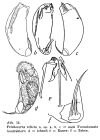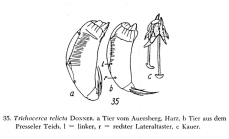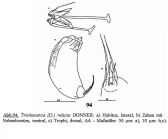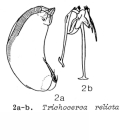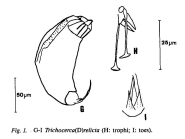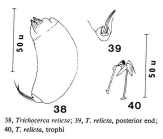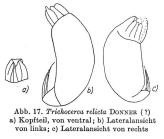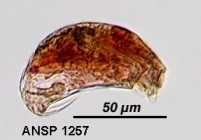WoRMS taxon details
Trichocerca relicta Donner, 1950
1796334 (urn:lsid:marinespecies.org:taxname:1796334)
accepted
Species
Diurella relicta (Donner, 1950) · unaccepted > superseded combination
brackish, fresh
Donner, J. (1950). Zur Rotatorienfauna Südmährens (IV). Beitrag zur Kenntnis der Gattung Trichocerca. Zoologischer Anzeiger, 145, 139-155
page(s): p.147, fig.12 [details] Available for editors [request]
[request]
page(s): p.147, fig.12 [details] Available for editors
Type locality contained in Austria
type locality contained in Austria [details]
Taxonomy The taxonomy of Trichocerca relicta Donner relative to T. obtusidens (Olofsson) requires further scrutiny. Conspecificity...
Taxonomy The taxonomy of Trichocerca relicta Donner relative to T. obtusidens (Olofsson) requires further scrutiny. Conspecificity of the two has been suggested by De Smet (1988:14), who erroneously gave priority to T. relicta, the later published name. Segers (2007) took the same line, but recognized the senior name T. obtusidens as the valid species name. Both species are unmistakable however, by a different morphology of their toes, a character which is not usually subject to significant variation in this group: both are equal in T. relicta, but of clearly different length and strength in T. obtusidens. Both names are therefore tentatively retained as valid here, until more information becomes available, particularly on the trophi morphology of T. obtusidens. [details]
Jersabek, C. D.; Segers H.; Leitner M. (2025). Rotifer World Catalog (RWC). Trichocerca relicta Donner, 1950. Accessed through: World Register of Marine Species at: https://www.marinespecies.org/aphia.php?p=taxdetails&id=1796334 on 2025-12-04
Date
action
by
![]() The webpage text is licensed under a Creative Commons
Attribution 4.0 License
The webpage text is licensed under a Creative Commons
Attribution 4.0 License
Nomenclature
original description
Donner, J. (1950). Zur Rotatorienfauna Südmährens (IV). Beitrag zur Kenntnis der Gattung Trichocerca. Zoologischer Anzeiger, 145, 139-155
page(s): p.147, fig.12 [details] Available for editors [request]
[request]
page(s): p.147, fig.12 [details] Available for editors
Other
 Present
Present  Present in aphia/obis/gbif/idigbio
Present in aphia/obis/gbif/idigbio  Inaccurate
Inaccurate  Introduced: alien
Introduced: alien  Containing type locality
Containing type locality
Nontype ANSP 1257, geounit New Jersey [details]
From editor or global species database
Environment saltwater occurrences include inland saline waters. [details]Habitat Bottom sediments; Bottom sediments (littoral sand, cobble, gravel); Bottom sediments, and POM; Littoral microhabitats; Macrophytes; Macrophytes (Ceratophyllum, Potamogeton); Macrophytes (Myriophyllum); Macrophytes (Myriophyllum, Potamogeton); Macrophytes (Myriophyllum, Potamogeton, Ranunculus); Macrophytes (Potamogeton pectinatus?); Macrophytes (Ranunculus); Macrophytes (semi-emersed), semi-terrestrial vegetation, and bottom sediments; Macrophytes (Utricularia, Nymphaea); Mixed sample: open water, and bottom sediments; Mixed sample: open water, and periphyton (on Ceratophyllum); Moss (Drepanocladus, Scapania); Moss (Sphagnum, peat moss); Moss (submersed); Mud surface; Open water; Open water (tychoplanktonic); Periphyton; Psammolittoral; Reed belt, open water between and periphyton on reed stems; Stream bottom: POM (sand, gravel); Stream bottom: POM (sand, gravel, mud); Water fern interrhizon (Azolla sp.), and bottom sediments [details]
Taxonomy The taxonomy of Trichocerca relicta Donner relative to T. obtusidens (Olofsson) requires further scrutiny. Conspecificity of the two has been suggested by De Smet (1988:14), who erroneously gave priority to T. relicta, the later published name. Segers (2007) took the same line, but recognized the senior name T. obtusidens as the valid species name. Both species are unmistakable however, by a different morphology of their toes, a character which is not usually subject to significant variation in this group: both are equal in T. relicta, but of clearly different length and strength in T. obtusidens. Both names are therefore tentatively retained as valid here, until more information becomes available, particularly on the trophi morphology of T. obtusidens. [details]
From editor or global species database
